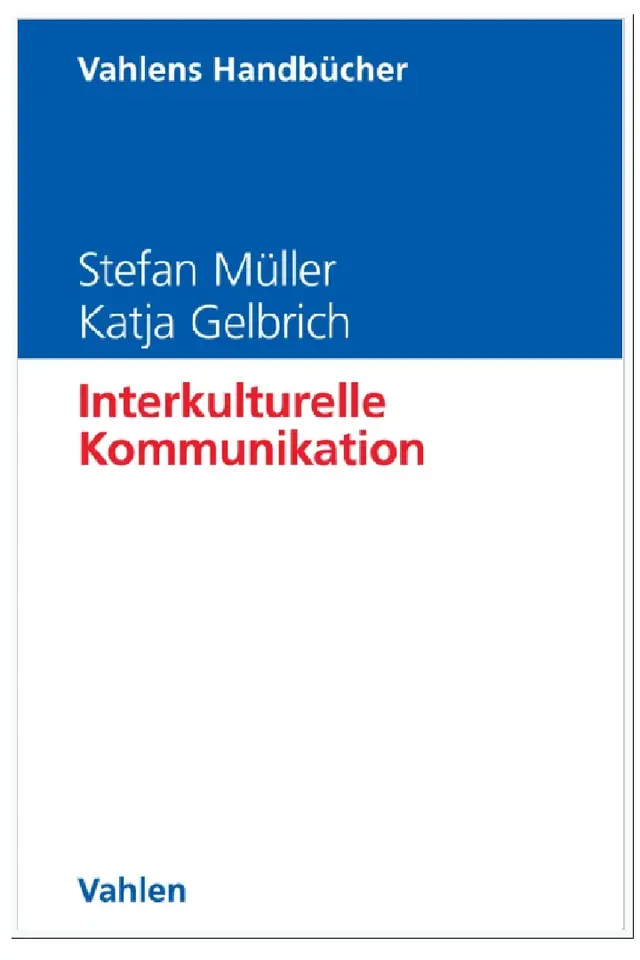Interkulturelle Kommunikation

Details
- Authors: Prof. Dr. Stefan Müller and Prof. Dr. Katja Gelbrich
- 2014, 515 pages: with 128 illustrations: hardback. Vahlen
- ISBN 78-3-8006-4600-5
Ordering option:
Content:
People communicate in many different ways. Only a few of the forms and contents of communication that can be observed are equally understood worldwide. Understanding therefore requires, among other things, that those involved are able to decode culture-specific signals, e.g: greeting formulas and rules of small talk (= verbal communication), voice pitch, tone of voice, and laughter (= paraverbal communication), facial expressions, gestures as well as type and duration of eye contact (= non-verbal communication), distance and closeness, physical greeting rituals, and guest gifts (= extra-verbal communication). Based on E. T. Hall's famous hypothesis that "communication is culture and culture is communication", the authors discuss the influence of national culture on communication. Against the background of culture-dependent world views, myths, heroes, rituals, symbols, taboos, norms, and values, they discuss the possibilities of understanding and misunderstanding. In addition to the peculiarities and regularities of interpersonal communication in cross-cultural interactions, the book deals with the basics of intercultural commercial communication. The latter covers print, TV and electronic advertising, public relations, sales promotion, sponsoring, comparative advertising, direct marketing, and recommendation management for target groups with different cultural orientations. A further chapter deals with the various styles of communication. These include styles of thinking, argumentation and negotiation as well as management styles and conflict styles.
Reviews:
- Review (Rezensionen.ch)
- further reviews:
"I will recommend your very successful textbook "Interkulturelle Kommunikation" to my students. One of the book's strengths is not only that it presents comprehensive concepts of intercultural communication in an understandable and structured way, but also that it contains numerous illustrative examples, often with an economic reference which is important for our students. With this, you are continuing the successful approach of your book "Interkulturelles Marketing", which I greatly appreciate."
Prof. Dr. Christoph Barmeyer, University of Passau
"Communication in one's own cultural environment often proves to be difficult. Communication processes become even more complex when representatives of different ethnic groups meet. Thus, it is not surprising that the cultural context is also becoming increasingly important in the working world, and, therefore, especially in city or university libraries. On the one hand, this affects library staff, on the other hand it affects library customers. Gestures and linguistic expressions easily lead to misunderstandings when one's own culture meets a foreign culture. If the communication process takes place in a foreign language, the problems become even more apparent. The Japanese, for example, have sixteen possibilities to say "no" (p. 107). Especially in a consulting situation, it is particularly helpful to know and understand the cultural codes, scripts and world views. For example, in societies with high differences in power and status, it can lead to dramatic incidents. For example, Korean Air machines happened to crash, because pilot and co-pilot were in a communicative hierarchical conflict situation (p. 11). In seven sections, the authors answer questions such as: "In which countries is it common to express praise or criticism?"; "Which topics of conversation are permitted or frowned upon in which cultures?"; "Why do Chinese people smile 'all the time'?". On a meta-level it is for example about "interpersonal communication", about the "influence of the national culture" or the "influence of religion". In detail it is about "small talk", "duration of eye contact", "welcoming rituals", "word games", or "farewell phrases". It is helpful for understanding that, in addition to the practice, the theoretical foundations and often the historical context are not ignored. An extensive index of keywords provides a useful additional benefit as a reference work in the area of "dealing with foreign cultures". If you want to delve deeper into the complex of "intercultural communication", there is no way around this easily understandable, very well structured book with numerous examples".
Readability: 1
Information content: 1
value for money: 1
Practical applicability: 1
Overall judgement: 1b.i.t.online - Zeitschrift für Bibliothek, Information und Technologie - see Reviews
Prof. Dr. Wolfgang Ratzek, Hochschule der Medien Stuttgart
Images from the book:
If you need illustrations from our book for your lectures, presentations, theses, etc., we will be happy to send them to you as PowerPoint files. Please address your request together with a short note on the intended use to:
The same applies to questions, tips, suggestions and criticism. We will answer you as soon as possible.